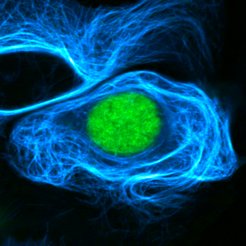A new dimension: HaloTag variants for fluorescence lifetime multiplexing
HaloTag variants enable tuning of fluorescence lifetime and allow imaging various proteins of interest using the same fluorophore and only one channel
Visualizing cellular mechanisms and molecular interactions in living cells is key for understanding biology. Self-labeling proteins such as the HaloTag have long been used to label proteins of interest with synthetic fluorophores to visualize them using fluorescence microscopy. Scientists at the Max Planck Institute for Medical Research have now developed three HaloTag variants that modulate the fluorescence lifetime of the fluorophore used. This means that the fluorophore will emit light at different times, making it possible to differentiate between the labeled proteins based on when fluorescence is detected rather than, e.g. the color of the fluorophore. This new technique enables scientists to study various proteins using the same fluorophore but different HaloTag variants at the same time. The key advantage of this approach – tuning of fluorescence lifetime of one and the same fluorophore – is that it allows imaging using only one channel for detection of the emitted fluorescent light – freeing up other channels to detect even more labeled structures. The results have recently been published in Nature Methods.
Fluorescence microscopy is a powerful tool to study cellular mechanisms and protein interactions in living cells. In order to visualize the desired proteins, they need to be tagged specifically with a fluorophore. To do so several techniques have been developed. A very common one is the use of the self-labeling protein tag HaloTag, which can be expressed as a fusion with proteins of interest. Cells expressing such HaloTag constructs can then be specifically labeled with a synthetic fluorophore, thus making the target protein visible under the microscope.

A common approach to adapt this labeling system to different experimental requirements is to control the properties of the fluorophore through chemical modifications. This often means a change in spectral properties such as the color (excitation and emission wavelength) of the fluorophore. As a consequence, different detection channels of the microscope are used to distinguish different fluorophores, allowing to study different proteins of interest simultaneously in a cell. This approach is called multiplexing. Yet, the number of available channels on most microscopes only ranges between three and five, limiting the number of different proteins that can be observed simultaneously. Studying complex cellular mechanisms where several proteins interact, however, greatly benefits from visualizing a larger number of molecules at the same time.
Therefore, Michelle Frei, former PhD student in the Chemical Biology Department at the MPI for Medical Research and colleagues, approached the problem from a different angle. Rather than modifying the fluorophore itself, they created HaloTag variants (HaloTag9, HaloTag10, HaloTag11) that modulate the brightness and fluorescence lifetime of the fluorophores attached through changes of the HaloTag structure close to the binging site of the fluorophore. Similar to distinguishing proteins of interest through the color of the fluorophore, fluorescence lifetime can be used to observe different proteins at once. Instead of detecting fluorophores of different colors, HaloTag variants 9, 10 and 11 are all labeled with the same fluorophore but their fluorescence lifetime differs. For example, a fluorophore on HaloTag10 will emit light earlier, while the same fluorophore on HaloTag9 will emit light later. This property allows the two tags to be distinguished. As only a single fluorophore was used, detection is possible using the same channel of the microscope. This leaves other channels open for imaging of other molecules and thus opens up new opportunities for multiplexing.
“Previously there were no generalized tags available for fluorescence lifetime multiplexing especially not in living cells. With our strategy it becomes straightforward to perform fluorescence lifetime multiplexing,” says Michelle Frei. “I was extremely excited to see that we can modulate the properties of the synthetic fluorophore by only a few point mutations on the surface of the protein. This really demonstrates once more the huge potential there is in hybrid approaches using both synthetic fluorophores and self-labeling protein tags and while many people work on either part it is really the synergy of both that lets us create even better tools.”
Frei is especially excited about future potential of the groups findings:” I think that the HaloTag variants will help to increase the use of fluorescence lifetime multiplexing not just as an alternative to spectral multiplexing but rather as a complementation. It will increase the number of channels that can be used to look at more targets simultaneously. Also, these HaloTag variants open up new avenues to create biosensors and lifetime-based tools.”
